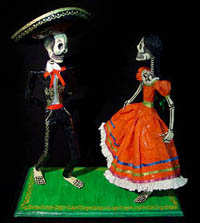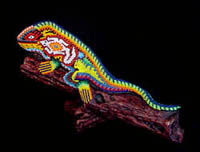


Shortly before dawn on September 16, 1810, Miguel Hidalgo y Costilla made a momentous decision that revolutionized the course of Mexican history. Hidalgo, a Catholic priest in the village of Dolores, ordered the arrest of Dolores’ native Spaniards. Then Hidalgo rang the church bell as he customarily did to call the Indians to mass. The message that Hidalgo gave to the Indians and Mestizos called them to retaliate against the hated Gachupines, or native Spaniards, who had exploited and oppressed Mexicans for ten generations. Although a movement toward Mexican independence had already been in progress since Napoleon’s conquest of Spain, Hidalgo’s passionate declaration was a swift, unpremeditated decision. "Mexicanos, Viva México!" Hidalgo told the Mexicans who were the members of New Spain’s lowest caste. He urged the exploited and embittered Mexicans to recover the lands that were stolen from their forefathers. That he was calling these people to revolution was a radical change in the original revolution plot devised by the criollos (Mexican-born Spaniards). Once the dean of the College of San Nicolas at Valladolid in Michoacan (now Morelia), Hidalgo was a well-educated, courageous humanitarian. He was sympathetic to the Indians, which was unusual amongst Mexican clergymen. Against gachupin law, Hidalgo taught Indians to plant olives, mulberries and grapevines and to manufacture pottery and leather. His actions irritated the Spanish viceroy who, as a punitive measure, cut down Hidalgo’s trees and vines.
Groups of criollos across Mexico had been plotting to overthrow the authority of gachupines who, because of their Spanish nativity, had legal and social priority over the criollos. When Joseph Bonaparte replaced King Ferdinand as the leader of Spain, the criollos recognized a prime opportunity for Mexican sovereignity. The nucleus of this movement was a group of intellectuals in Querétaro led by the corregidor of Querétaro, his wife and a group of army officers distinguished by the adventurous Ignacio Allende. The criollos plan for revolution did not originally focus on the manpower of the Mexicans. Rather, the criollos sought to avoid military confrontation by convincing criollo army officers to sever their allegiance to the gachupines. By claiming loyalty to the defeated King Ferdinand, the criollos aimed to establish Mexico as an independent nation within King Ferdinand’s Spanish empire. The gachupines who claimed authority under Bonaparte’s rule would be driven out of Mexico. Hidalgo had close ties with this group. Approaching sixty years of age, Hidalgo was beloved and greatly respected by Mexicans. Gachupines were alerted to the criollos independence movement by criollo officers who had refused to join the revolutionary movement and by a priest who had learned of the plot through a confessional. Hidalgo was among the central figures targeted for arrest on September 13, 1810. The Querétaro corregidor’s wife informed the criollos of the gachupines plan. Allende immediately departed from Quértaro to inform Hidalgo. Allende arrived in Dolores in the early morning hours of September 16. His message forced Hidalgo to make the most significant decision of his life, a decision which marked the first struggle for Mexican independence and that would distinguish Hidalgo as the national hero of the revolution. The criollos had not gained enough military alliance to forfeit the gachupines rule, as the plot had leaked three months before the criollos target date of December 8. Hidalgo had three possible options. He could await arrest, flee Dolores or call on the Indian and mestizo forces. His decision to call the exploited groups to revolution completely changed the character of the revolution. The movement became a bloody class struggle instead of a shrewd political maneuver. When Hidalgo called the Indians to action, he tapped into powerful forces that had been simmering for over three hundred years. With clubs, slings, axes, knives, machetes and intense hatred, the Indians took on the challenge of the Spanish artillery. When the indian and mestizo forces, led by Hidalgo and Allende, reached the next village en route to Mexico city, they acquired a picture of the Virgin of Guadalupe, the patron saint whose image was of a woman of color. The Virgin of Guadalupe, who was indigenous to Mexico, became the banner of the revolutionary forces as Hidalgo and Allende led the path toward Mexico City and the expulsion of the gachupines.
Hidalgo later regretted the bloodbath he had incited with his fateful cry of Dolores. When he made his hasty decision in the pre-dawn hours of September 16, he had not foreseen the mass slaughter of Spaniards. Before the revolutionary troops descended upon Mexico City, Hidalgo retreated with only a few associates to Dolores, where he would be executed by the gachupines only a year later. Despite his ambiguity toward the violent class struggle that was the Mexican revolution, Hidalgo is still revered as the father of Mexican independence. Eleven years of war, decades of despotic Mexican rulers and political unrest proceeded Hidalgo's cry of Dolores. Yet throughout the years of turmoil, El Grito de Dolores, "Mexicanos, viva México," has persevered. Every year at midnight on September 15, Mexicans shout the grito, honoring the crucial, impulsive action that was the catalyst for the country's bloody struggle for independence from Spain.
You can watch a small video of last year's Grito de Dolores in the Zocalo of Mexico City here.
We'll be working on the alebrijes updates and the next issue of Noticias and will get it out to you as soon as possible; until then: ¡Saludos!